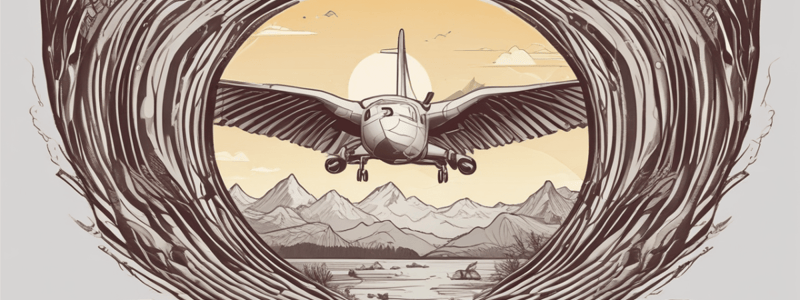Podcast
Questions and Answers
What is the main purpose of using the correct tools in maintenance and repairs?
What is the main purpose of using the correct tools in maintenance and repairs?
- To show off your skills to others
- To work quickly, accurately and safely (correct)
- To prolong the life of the equipment
- To increase efficiency and reduce costs
What is a consequence of using the wrong tool for a job?
What is a consequence of using the wrong tool for a job?
- The equipment may be damaged or the tool itself may be damaged (correct)
- The tool will become more efficient
- The tool will become obsolete
- The job will be done faster
What is the purpose of the International Organisation for Standardisation (ISO)?
What is the purpose of the International Organisation for Standardisation (ISO)?
- To train maintenance personnel
- To regulate the use of tools
- To produce international standards (correct)
- To develop new tools and equipment
What should you avoid doing with tools when machinery or aircraft engines are running?
What should you avoid doing with tools when machinery or aircraft engines are running?
Why is it important to choose the correct tools for a job?
Why is it important to choose the correct tools for a job?
What can happen if you use a damaged screwdriver?
What can happen if you use a damaged screwdriver?
What is a good practice for tool control?
What is a good practice for tool control?
What can happen if you do not use the correct tools and follow proper maintenance procedures?
What can happen if you do not use the correct tools and follow proper maintenance procedures?
Why should you conduct a thorough inventory of tools after use?
Why should you conduct a thorough inventory of tools after use?
What is the estimated cost of foreign object damage (FOD) to the global aerospace industry annually?
What is the estimated cost of foreign object damage (FOD) to the global aerospace industry annually?
What should you do with oily, dirty, and greasy tools?
What should you do with oily, dirty, and greasy tools?
Why is it important to organize your tools in your toolbox?
Why is it important to organize your tools in your toolbox?
What is the primary reason for maintaining the original crowned shape of a punch shank end?
What is the primary reason for maintaining the original crowned shape of a punch shank end?
What is the result of continuously hammering a punch shank?
What is the result of continuously hammering a punch shank?
What is the primary use of prick punches?
What is the primary use of prick punches?
What should be done to a punch shank that has deformed to the shape of a mushroom?
What should be done to a punch shank that has deformed to the shape of a mushroom?
Why should prick punches never be used to drive a pin or rivet from a hole?
Why should prick punches never be used to drive a pin or rivet from a hole?
What is the purpose of witness marks made by prick punches?
What is the purpose of witness marks made by prick punches?
What is the purpose of a safe edge on a file?
What is the purpose of a safe edge on a file?
What determines the rate of cutting and the finish given to the work?
What determines the rate of cutting and the finish given to the work?
What is the purpose of a file's tang?
What is the purpose of a file's tang?
What are the different arrangements of cutting teeth on a file called?
What are the different arrangements of cutting teeth on a file called?
What is the term for the surface finish obtained by a file?
What is the term for the surface finish obtained by a file?
What are the two main ways files are used?
What are the two main ways files are used?
What is the primary purpose of a bastard cut file?
What is the primary purpose of a bastard cut file?
What is the main difference between a flat file and a hand safe edge file?
What is the main difference between a flat file and a hand safe edge file?
What is the primary benefit of using a smooth cut file?
What is the primary benefit of using a smooth cut file?
What is the characteristic of a double-cut file?
What is the characteristic of a double-cut file?
What is the benefit of using a file with a curved profile?
What is the benefit of using a file with a curved profile?
What is the purpose of a second cut file?
What is the purpose of a second cut file?
Flashcards are hidden until you start studying
Study Notes
Standards and Tool Control
- International standards are produced by the International Organisation for Standardisation (ISO)
- Documented standards consult several stakeholders
- Tool control affects safety, and its importance is emphasized in aircraft maintenance
Tool Care and Maintenance
- Tools are designed to make work easier and more efficient
- Tools must be properly used and cared for to maintain their advantages
- Choose the correct tool for the job to ensure quick, accurate, and safe work
- Preventative maintenance prolongs the usefulness of tools
- Use each tool only for its intended purpose to avoid damage or injury
- Keep tools clean and free from dirt, grease, and foreign matter
- Organize tools to easily access frequently used ones
- Avoid accumulating unnecessary tools
Safety Precautions for Tool Use
- Never leave tools scattered about or on top of machinery or electrical equipment
- Avoid using damaged tools, as they can cause injury or damage
- Clean tools after each use to prevent slips and accidents
- Conductor a thorough inventory of tools after use to prevent loss
- Remember, improper tool use results in improper maintenance, which can lead to damage and injury
Toolbox Organisation and Safety Risks
- Organise tools for easy access to frequently used ones
- Avoid accumulating unnecessary tools
- Tool control affects safety, and misplaced tools can cause damage or injury
- Foreign object damage (FOD) costs the global aerospace industry $4 billion annually
Punches and Chisels
- Hit punches squarely and keep their heads free of burrs to prevent mushrooming
- Remove mushroom shapes from punches using a bench grinder
- Prick punches are used to transfer dimensions and locations onto sheet metal for drilling
- Avoid using prick punches to drive pins or rivets from holes
Files and Filing
- Familiarise yourself with the parts of a file: tang, heel, faces, edges, point, and back
- Files can be used for roughing or finishing processes
- The rate of cutting and surface finish depend on the depth and spacing of the file's cutting teeth
- Different cuts and types of files are suited for working on different metals
- Common cuts include rough, middle, bastard, second cut, smooth, and dead smooth
Studying That Suits You
Use AI to generate personalized quizzes and flashcards to suit your learning preferences.




